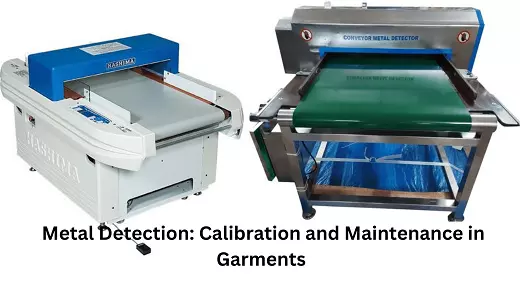Metal Detection Process: Calibration and Metal Detector Maintenance in the Garments Industry
To provide industry guidelines to everyone who is related to the supply chain, make understand, identify, and mitigate critical safety hazards associated with apparel and accessories designed and marketed. Apart from this, the garment industry produces folded/packed Garments, so it is a huge challenge for it to keep its product free from any metal. This operating procedure has been designed and standardized to take required precautions and preventive action to ensure all the final products produced by the garment Industry are free from any metals. In this article, we present Metal Detection Process: Calibration and Metal Detector Maintenance in the Garments Industry.
Metal Detection Process in the garments industry is the final detection or scanning system for needles, needle-broken parts, and any metals to make products metal-free and safe to wear. In the garment industry, ensuring product safety, quality, and compliance with international standards is paramount. Metal detection processes have become indispensable in maintaining high standards of safety and quality within this sector.
You must check that the metal detector is working fine and that it can detect all types of metal. We can do machine Calibration to get the machine’s performance. Metal Detector machine calibration and Maintenance are described below.

Metal Detection Process with Detail Procedure
- Prior to packaging, each and every garment should be passed through a metal detection machine one by one to ensure 100% metal contamination-free product packaging.
- During regular metal detection, after passing through the conveyor belt without any contamination signal, garments should be kept in a quarantined waiting zone (yellow box) until the next successful calibration.
- In case of any unsuccessful calibration, all the garments of the quarantined waiting zone (yellow box) should be checked again after the machine is rectified. Rectification of the machine should be carried out with the guidance of the machine supplier.
- If any garments are detected as metal-contaminated garments while passing through the conveyor belt, effort should be made to extract the metal part(s) from those garments. If the metal part(s) can be removed and the garments pass through the conveyor belt without a signal after that, then the garments are allowed to go for the next process. If the metal part(s) is /are not unidentified, extracted garments should be quarantined in the lockable red box.
- During emergency metal detection (isolated garment(s) come from sewing or finishing with the suspicion of metal contamination), apart from regular calibration, special calibration should be done prior to checking isolated garments. All the isolated garment(s) should be checked by passing through the metal detector machine and extracting the contaminated garments. If the contaminated garment(s) found, it should be locked in the designated red box and rest non-contaminated garment(s) should be send back to production process otherwise (if contaminated garments not found) all the isolated garments should be locked in the designated red box.
- Style wise record should be kept in metal detection report for both regular metal detection and emergency metal detection
Metal Detector Machine Calibration Procedures
- The machine must be placed away from other sources with magnetic fields such as clutch break mechanisms in sewing machines and ceiling fans. The machine must be kept always clean and in tidy condition.
- The operator of the metal detector machine must be pre-trained for operating the metal detector machine and the standard operating procedure for his/her job. Operator should not fiddle or try to adjust the machine unless he is authorized and trained to do so.
- The detector must be calibrated during switch on the machine before beginning of work at morning and after lunch break. Apart from this, minimum once per every two working hour machine should be calibrated.
- To calibrating the machine, among three option of the sensitivity level (0.8/1.0/1.2) customer requirement should be followed. If customer requirements is not available, factory standard 1.2 should be followed. In a same day, if there is more than one customer having different sensitivity level (among this three option) requirement, in that case lowest option should be followed.
- To do the calibration, According to selected sensitivity level of the day, applicable ferrous card should be mounted on a non-detectable block (plastic or another inert material) such that it passes through 9 different position of the machine aperture, in where the center point is of least sensitivity.
- Both head (if applicable) of the machine should be calibrated.
- If the detector fails a calibration check, all products coming after the previous successful calibration, must be re-checked after the machine is rectified. Rectification of the machine should be carried out with the guidance of the machine supplier.
- Apart from regular routine calibration, if any isolated garment(s) come from sewing or finishing with the suspicion of metal contamination, a special calibration should be done prior to check those isolated garments.
- Apart from regular routine calibration, a special calibration should be done before re-passing finished product through metal detector which has taken for any kind of inspection.
- All type of calibration record (whether regular or emergency) must be kept in metal detector calibration record.
Metal Detector Maintenance Procedures
- All personnel involved in the use of the metal detection unit must be trained by supplier to understand the metal detection system, the operation procedures and how to make or correct necessary adjustments for calibration check.
- Records of authorized operator need to be kept. The nominated person responsible for the operation of the unit needs to be documented.
- The detection unit must be serviced at regular intervals according to maintenance requirements from the supplier. Maintenance records must be kept for review during the audit.
Conclusion
Metal detection processes have become indispensable in the garment industry, providing a crucial layer of safety, quality control, and compliance. As technology evolves, these processes will continue to play a pivotal role in ensuring consumer safety, upholding quality standards, and preserving the integrity of garment manufacturers worldwide. The Metal Detector machine’s calibration and Maintenance procedure is also important to know.
- You would love to read : Needle Management Procedures in the Garments Industry.
- Job Responsibilities of Fire safety officer in the Garments
- Health and Safety Requirements in the Garments Industry
- C-TPAT Requirements and Procedure in Garments Industry
- Material Safety Data Sheet (MSDS) for Chemical in Textile and Apparel
- Product Safety and Regularity Defects in the Garments Industry
- Sharp Tools Control Procedures in the Garments Industry
- Product Safety Requirements in Garments Industry


